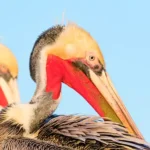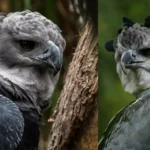California woodpeckers, numbering 17 unique species, play an important role in ecosystem health by controlling insects and aiding forest regeneration. Let’s read in detail about these woodpeckers.
17 Types Of Woodpeckers In California
1.Acorn Woodpecker:

Acorn Woodpeckers sport a striking combination of black, white, and red plumage, with unique facial patterns. They inhabit oak woodlands in California year-round, where they store acorns in tree cavities.
These communal birds are known for their habit of storing acorns in ‘granaries’ in trees. They also consume insects and sap.
- Length: 7.5-9.1 in (19-23 cm)
- Weight: 2.3-3.2 oz (65-90 g)
- Wingspan: 13.8-16.9 in (35-43 cm)
- Location to see:-Acorn Woodpeckers are not native to Florida. They are typically found in the western United States.
2.Northern Flicker:
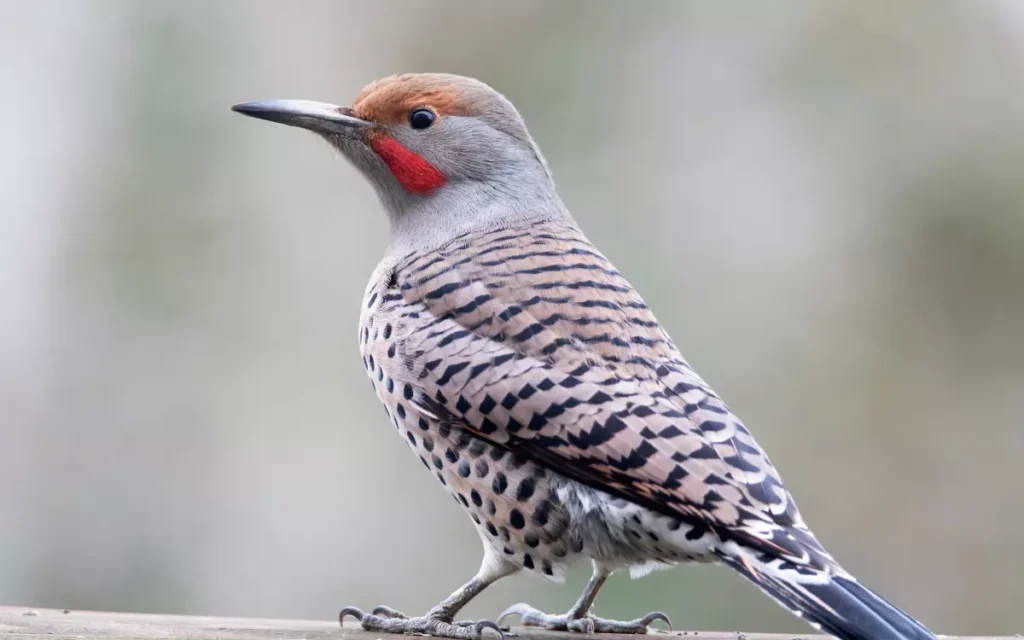
Northern Flickers are known for their tan plumage with black bars and a distinct white rump. They exhibit two main variations – the yellow-shafted and the red-shafted.
These woodpeckers are year-round residents throughout California, with some individuals migrating locally.
Northern Flickers are often found on the ground foraging for ants and beetles, supplementing their diet with berries and seeds.
- Length: 11.0-12.2 in (28-31 cm)
- Weight: 3.9-5.6 oz (110-160 g)
- Wingspan: 16.5-20.1 in (42-51 cm)
- Location to see:-You can often find Northern Flickers in Florida in open woodlands, grasslands, and urban areas.
3.Red-breasted Sapsucker:

These woodpeckers display striking red throats and heads, making them easy to identify.
Red-breasted Sapsuckers are present year-round in the coastal and mountainous regions of California.
They create sap wells in trees to feed on sap and insects attracted to it.
- Length: 7.9-8.7 in (20-22 cm)
- Weight: 1.9-2.2 oz (53.1-63.5 g)
- Wingspan: 14.6-16.0 in (37-40.6 cm)
- Location to see:-Red-breasted Sapsuckers are not commonly found in Florida; they prefer western regions of North America.
4. Hairy Woodpecker:
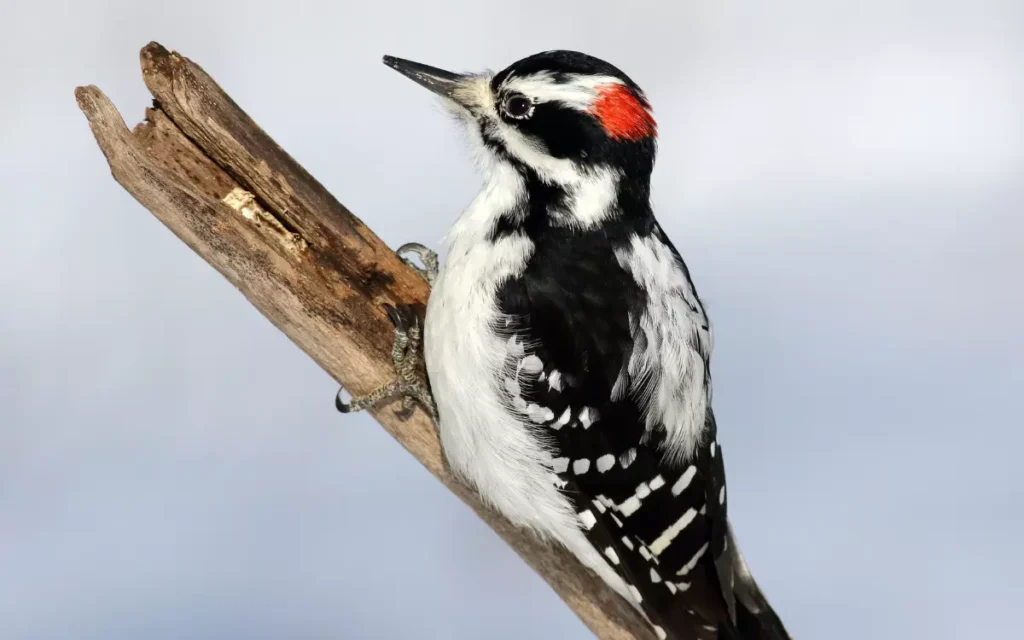
Hairy Woodpeckers resemble Downy Woodpeckers but are larger, with no distinct variations.
They are found year-round across California. Similar to Downy Woodpeckers, Hairy Woodpeckers feed on insects, seeds, and fruits.
- Length: 7.1-10.2 in (18-26 cm)
- Weight: 1.4-3.4 oz (40-95 g)
- Wingspan: 13.0-16.1 in (33-41 cm)
- Location to see:-Hairy Woodpeckers also inhabit various woodlands and residential areas throughout Florida.
5. Downy Woodpecker:
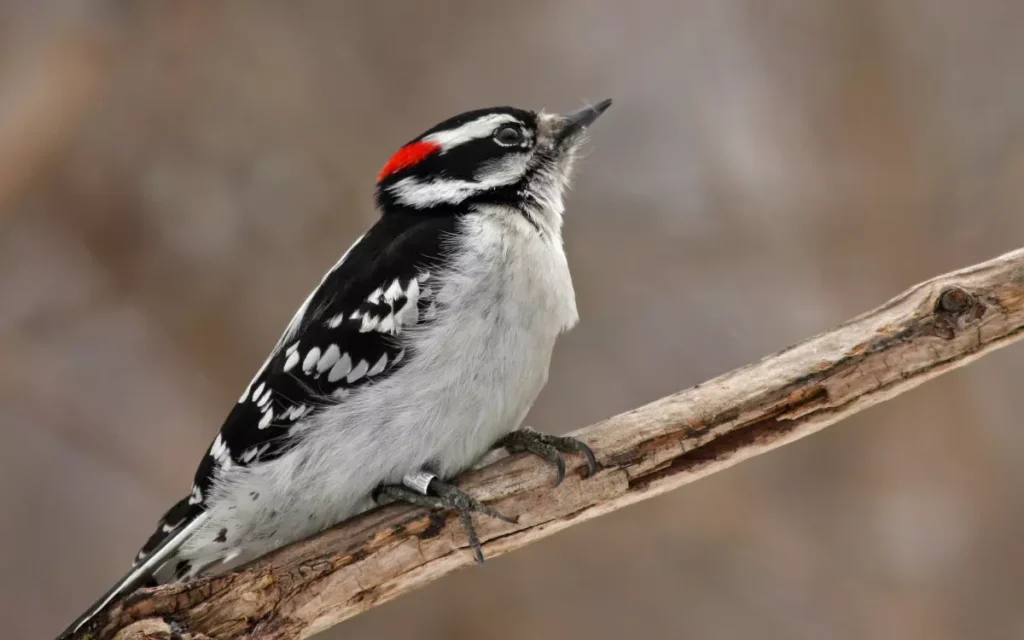
Downy Woodpeckers are small with white undersides and black wings adorned with white spots.They are widespread across California, staying throughout the year.
Downy Woodpeckers are often seen foraging for insects on tree trunks and branches and enjoy seeds and berries.
- Length: 5.5-6.7 in (14-17 cm)
- Weight: 0.7-1.0 oz (21-28 g)
- Wingspan: 9.8-11.8 in (25-30 cm)
- Location to see:-Downy Woodpeckers are widespread in Florida and can be seen in forests, parks, and even suburban areas.
6. White-headed Woodpecker:

White-headed Woodpeckers have unique white heads and bodies with black wings.
They primarily inhabit the coniferous forests of northern and central California year-round. Their diet consists of insects, tree sap, and pine seeds.
- Length: 8.3-9.1 in (21-23 cm)
- Weight: 1.9-2.3 oz (55-65 g)
- Wingspan: 20 cm (7.9 in)
- Location to see:-White-headed Woodpeckers are primarily found in the western United States and are not native to Florida.
7. Pileated Woodpecker:
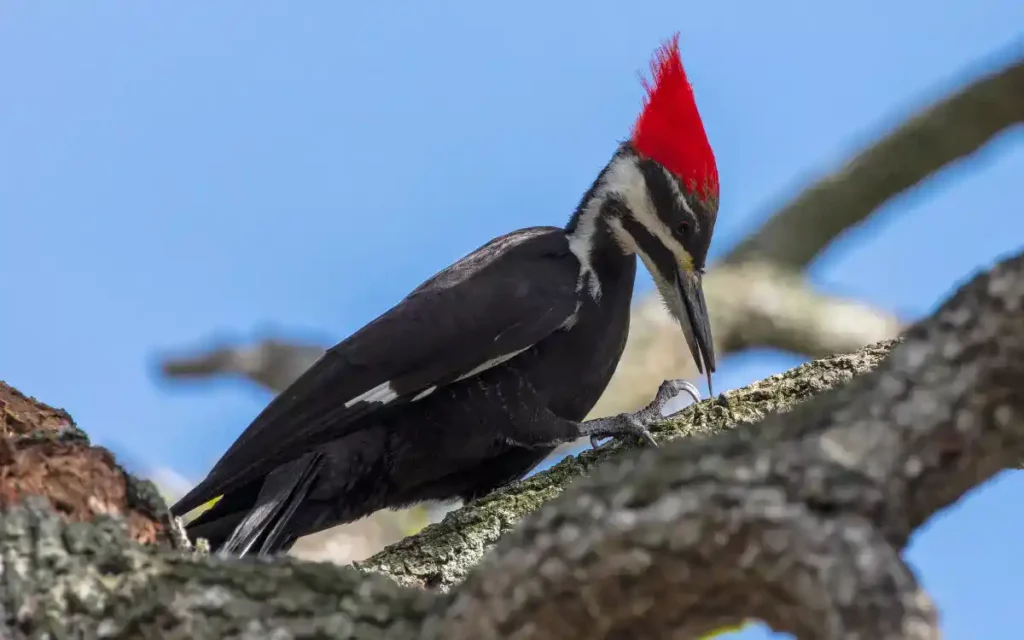
Pileated Woodpeckers are the largest woodpeckers in North America, with striking black bodies, red crests, and white stripes.
They can be found in forested areas across California year-round. Pileated Woodpeckers are skilled at excavating large holes in search of insects and larvae.
- Length: 15.8-19.3 in (40-49 cm)
- Weight: 8.8-12.3 oz (250-350 g)
- Wingspan: 26.0-29.5 in (66-75 cm)
- Location to see:-Pileated Woodpeckers are among the most iconic woodpeckers in Florida and can be seen in forests and wooded areas statewide.
Read also:-
- 11 Birds similar to woodpeckers (ID & Info)
- 8 Woodpeckers of South Carolina (Photo,info)
- 10 Woodpeckers in Florida (Id & Pic)
- 9 Woodpeckers in New Hampshire (Photo & ID)
- 8 ways to Get Rid of Woodpeckers
8. Ladder-backed Woodpecker:
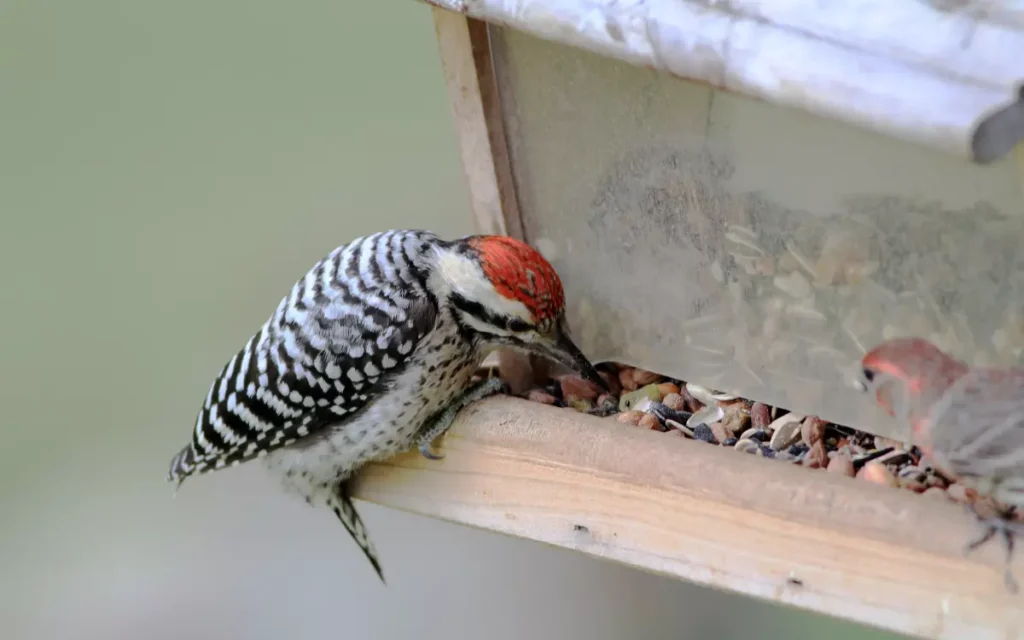
These woodpeckers have ladder-like black and white markings on their backs.
They inhabit the southern regions of California year-round. Ladder-backed Woodpeckers mainly feed on insects and tree sap.
- Length: 6.3-7.1 in (16-18 cm)
- Weight: 0.7-1.7 oz (21-48 g)
- Wingspan: 13.0 in (33 cm)
- Location to see:-Ladder-backed Woodpeckers are typically found in the southwestern United States and are not commonly seen in Florida.
9. Lewis’s Woodpecker:

Lewis’s Woodpeckers are known for their iridescent green plumage and pinkish-red bellies.
They reside in parts of California, especially in the Sierra Nevada foothills. Their diet includes flying insects, acorns, and fruits.
- Length: 10.2-11.0 in (26-28 cm)
- Weight: 3.1-4.9 oz (88-138 g)
- Wingspan: 19.3-20.5 in (49-52 cm)
- Location to see:-Lewis’s Woodpeckers are rare in Florida, and their sightings are infrequent; they prefer western and mountainous regions.
10. Williamson’s Sapsucker:
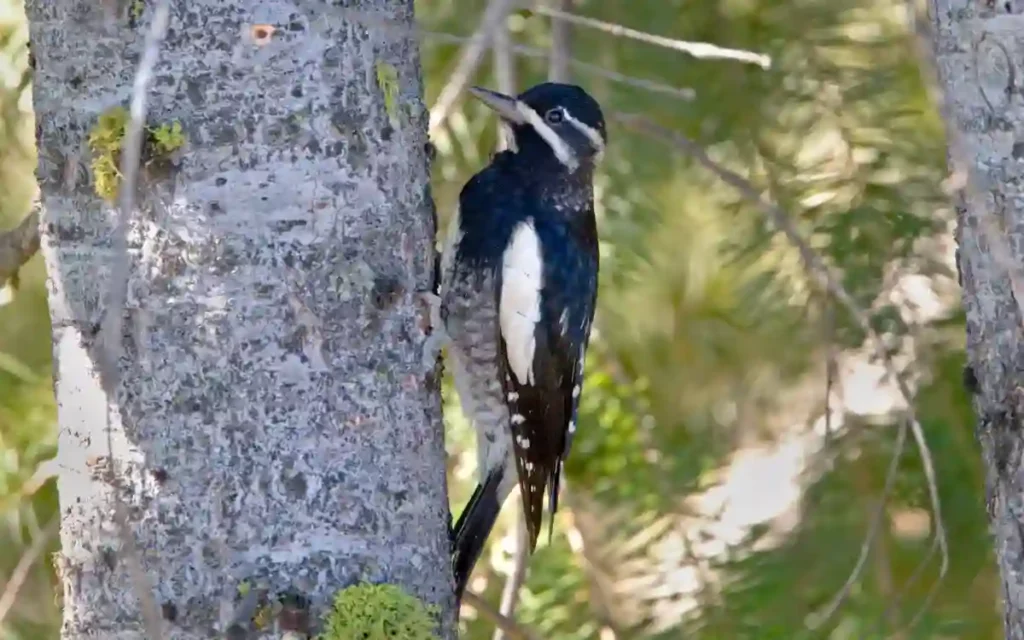
Williamson’s Sapsuckers are striking with black and white plumage and a bright red throat.
They are primarily found in the mountains of northern California. Their diet consists mainly of tree sap and insects.
- Length: 8.3-9.8 in (21-25 cm)
- Weight: 1.6-1.9 oz (44-55 g)
- Wingspan: 7 in (43 cm)
- Location to see:-Williamson’s Sapsuckers are not native to Florida; they mainly inhabit western North America.
11. Yellow-bellied Sapsucker:
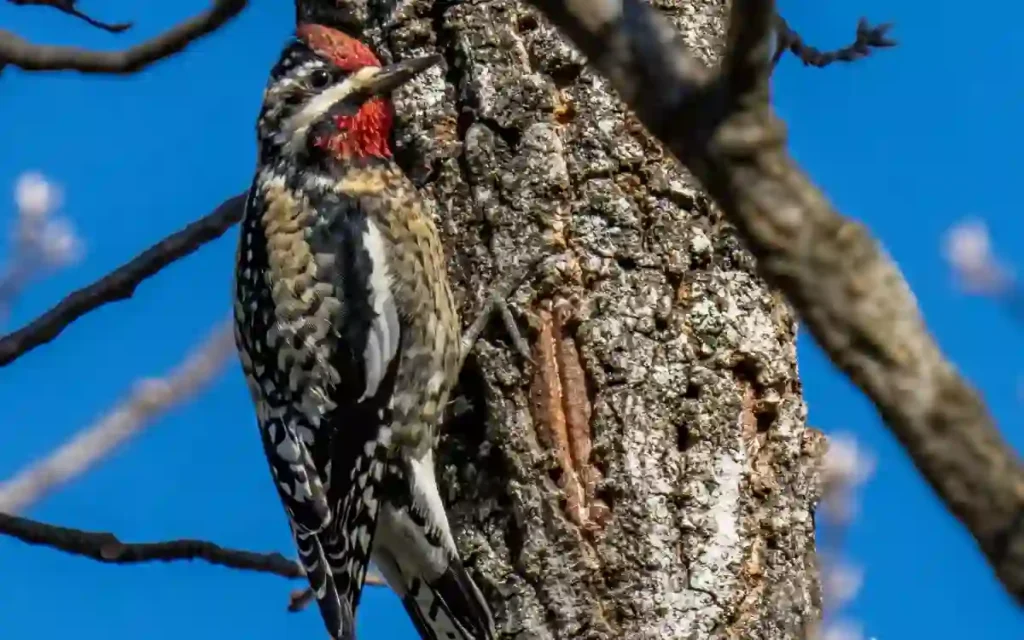
These woodpeckers have distinctive black and white plumage with a yellow belly.
They are migratory birds that visit California during the winter months. Yellow-bellied Sapsuckers feed on tree sap, insects, and fruits.
- Length: 7.1-8.7 in (18-22 cm)
- Weight: 1.5-1.9 oz (43-55 g)
- Wingspan: 13.4-15.8 in (34-40 cm)
- Location to see:-Yellow-bellied Sapsuckers may migrate through Florida during the winter months, particularly in the northern parts of the state.
12. Gila Woodpecker:

Gila Woodpeckers have brown bodies with black and white markings.They are residents of the desert regions in Southern California.
Their diet includes insects, fruits, and cactus flower nectar.
- Length: 8.7-9.4 in (22-24 cm)
- Weight: 1.8-2.8 oz (51-79 g)
- Wingspan: 15.8-16.5 in (40-42 cm)
- Location to see:- Gila Woodpeckers are not native to Florida; they are primarily found in the southwestern United States.
13. Black-backed Woodpecker:

Black-backed Woodpeckers are predominantly black with white undersides and a yellow cap.
They can be found in coniferous forests in the northern part of the state. They feed on wood-boring insects, especially in burnt or dead trees.
- Length: 9.1 in (23 cm)
- Weight: 2.1-3.1 oz (61-88 g)
- Wingspan: 15.8-16.5 in (40-42 cm)
- Location to see:-Black-backed Woodpeckers are not commonly seen in Florida; they prefer northern and mountainous regions.
14. Red-headed Woodpecker:
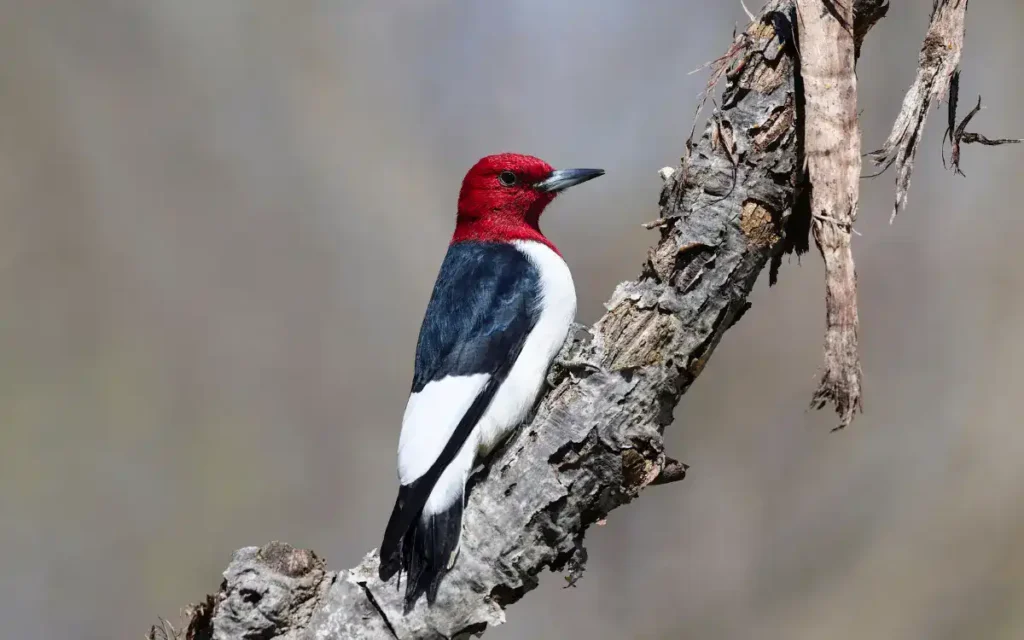
These woodpeckers have a striking red head, white body, and black wings.They migrate to California during the winter months.
Red-headed Woodpeckers consume insects, fruits, and nuts.
- Length: 7.5-9.1 in (19-23 cm)
- Weight: 2.0-3.2 oz (56-91 g)
- Wingspan: 16.5 in (42 cm)
- Location to see:-Red-headed Woodpeckers are present in some parts of Florida, especially in the northern and central regions.
15. Red-naped Sapsucker:

Red-naped Sapsuckers have red throats and napes with black and white plumage.
They are migratory and visit California during the winter. These sapsuckers primarily feed on tree sap and insects.
- Length: 7.5-8.3 in
- Weight: 1.1-2.3 oz
- Wingspan: 16.1-16.9 in
- Location to see:-Red-naped Sapsuckers are migratory and may pass through Florida during the winter months, particularly in the northern areas.
16. Nuttall’s Woodpecker:
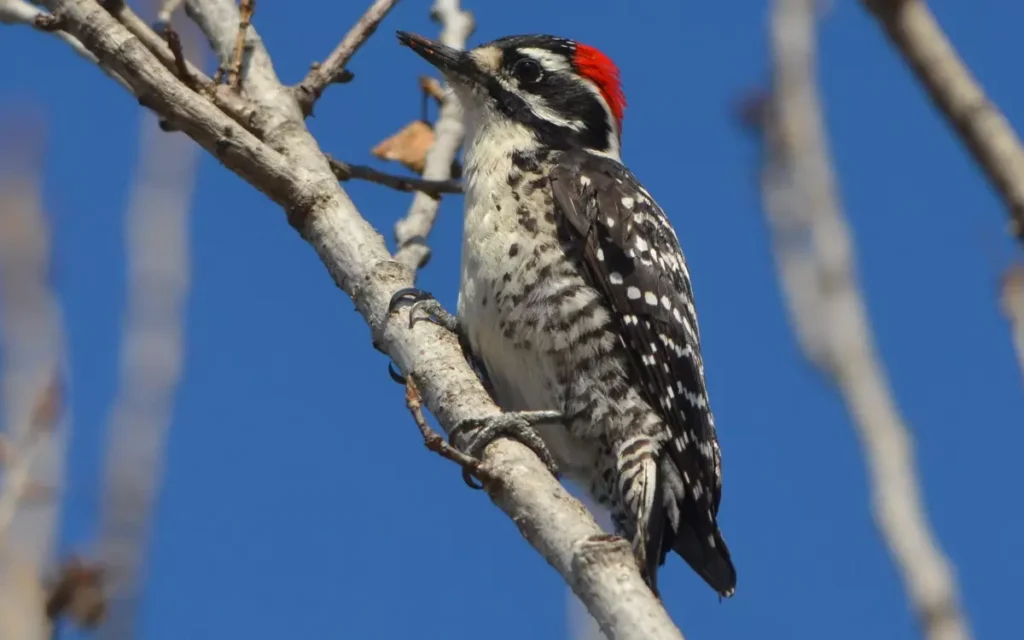
Nuttall’s Woodpeckers are black and white with distinct white spots on their wings.
They are year-round residents of California’s oak woodlands. Their diet consists mainly of insects and acorns.
- Length: 6.3-7.1 in
- Weight: 1.1-1.6 oz
- Wingspan: 13.0-16.1 in
- Location to see:-Nuttall’s Woodpeckers are not native to Florida; they are primarily found in the western United States.
17. Gilded Flicker:
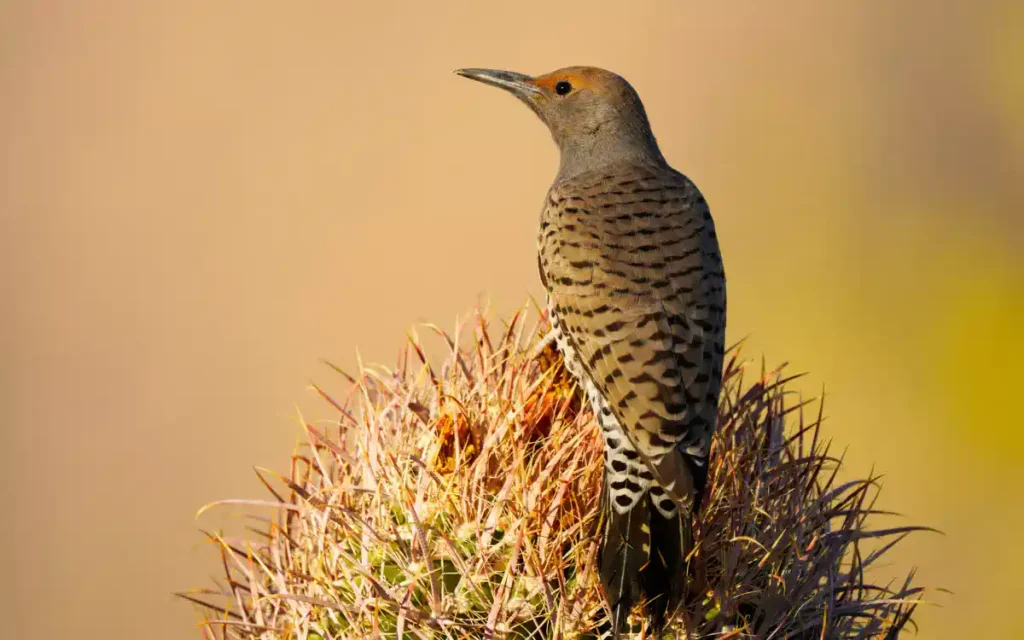
Gilded Flickers are large woodpeckers with golden-yellow undersides and black markings.
They are found in desert regions of Southern California year-round. Gilded Flickers feed on ants, termites, and cactus fruits.
- Length: 8.3-9.1 in
- Weight: 1.9-2.3 oz
- Wingspan: 16.9 in
- Location to see:-Gilded Flickers are not native to Florida; they are typically found in the southwestern United States.
Read also:-
- 8 Woodpeckers of South Carolina (Photo,info)
- 10 Woodpeckers in Florida (Id & Pic)
- 9 Woodpeckers in New Hampshire (Photo & ID)
- 8 ways to Get Rid of Woodpeckers
FAQS:
Q: What kind of woodpeckers live in California?
Ans: California is home to several woodpecker species, including the Acorn Woodpecker, Nuttall’s Woodpecker, Downy Woodpecker, Hairy Woodpecker, Northern Flicker, and the Pileated Woodpecker, among others.
Q: What do California woodpeckers eat?
Ans: California woodpeckers primarily eat insects, nuts, seeds, and fruit. Some species, like the Acorn Woodpecker, are known for storing acorns in tree bark.
Q: What is the most common woodpecker in the US?
Ans: The most common woodpecker in the US is the Downy Woodpecker, which is widely distributed across the country.
Q: What does a woodpecker symbolize?
Ans: A woodpecker symbolizes determination, persistence, and the importance of communication and opportunity. In various cultures, it can also represent protection and strength.
Conclusion:
California woodpeckers play a vital role in our ecosystems by controlling insect populations and helping forests stay healthy. Their Different species and special behaviors make them fascinating subjects for both study and observation. Protecting their habitats is crucial for maintaining Biological variability.




